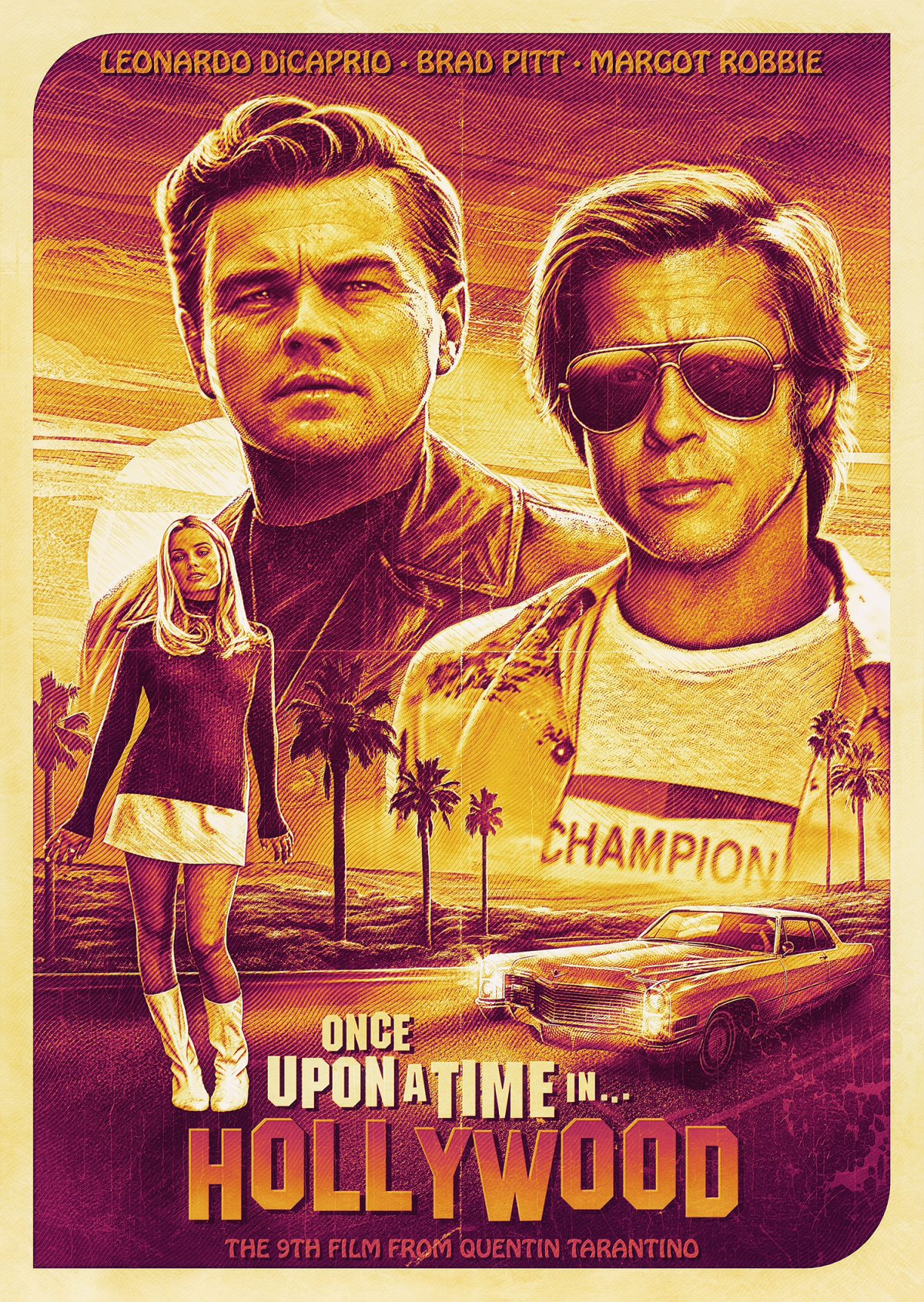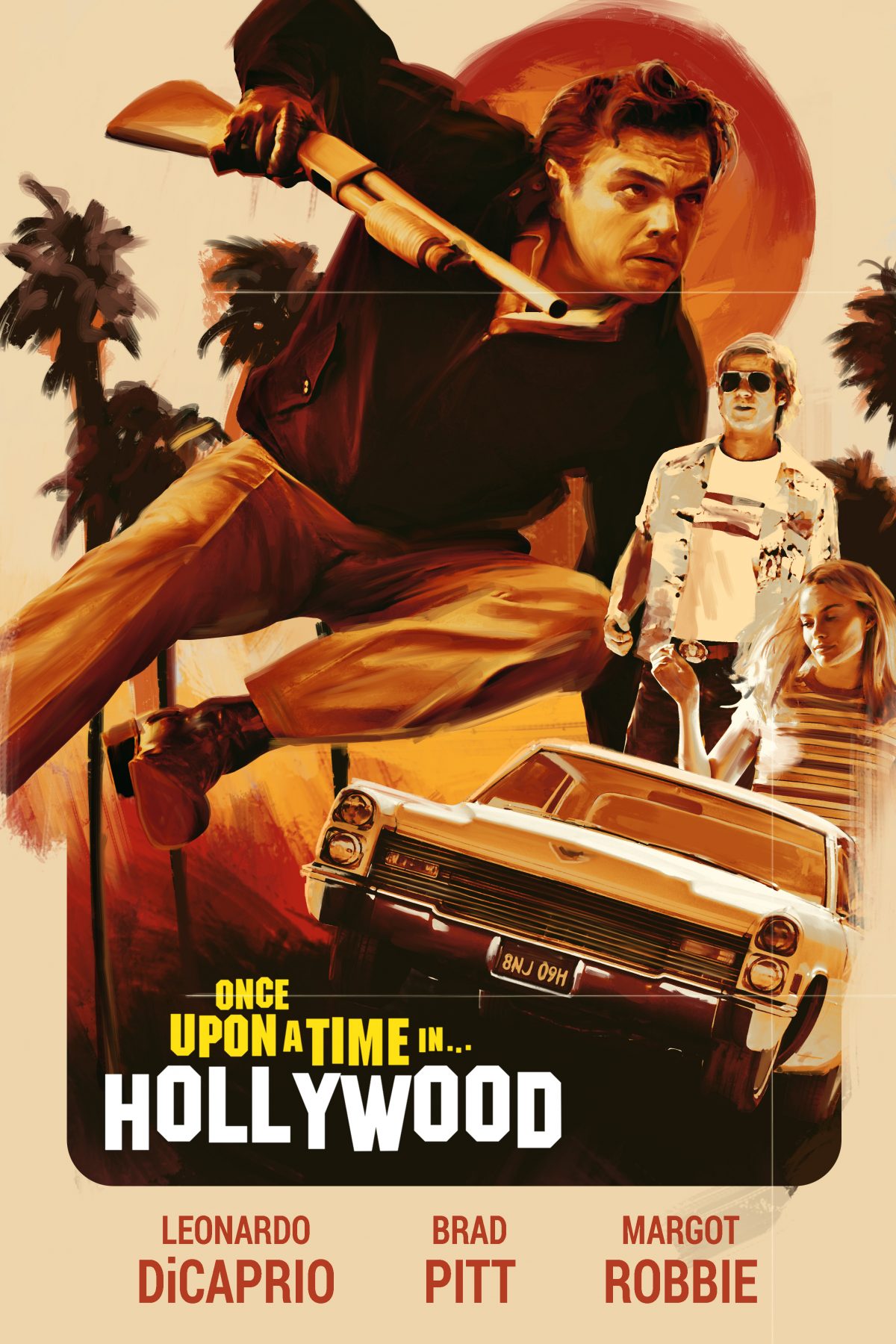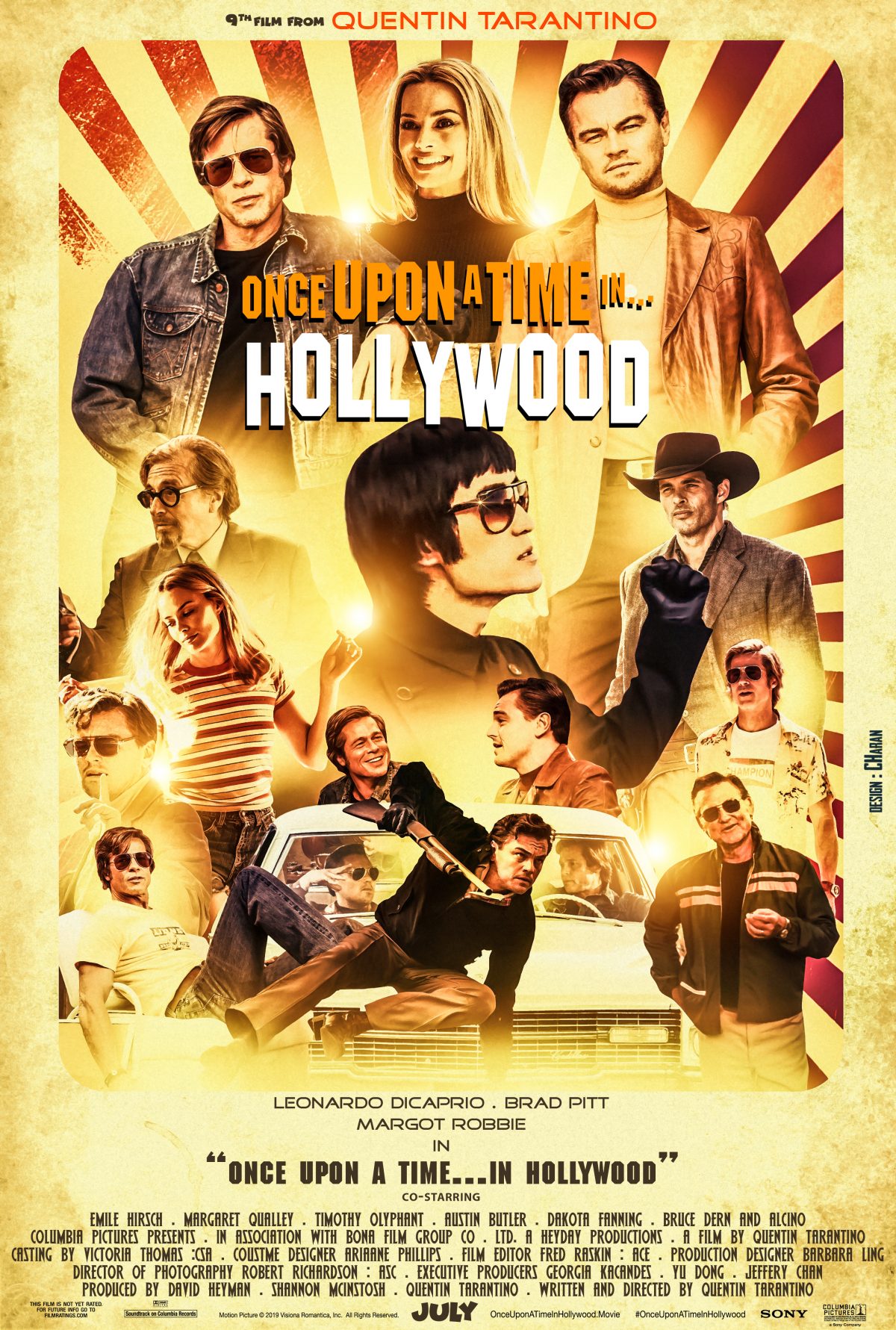Unpacking The Iconic Once Upon A Time In Hollywood Poster
When we think about a truly memorable movie, the images that stick with us often extend far beyond the scenes on screen. In a way, the promotional artwork, particularly the main poster, becomes a shorthand for the entire experience. It's almost like a visual invitation, a promise of the story waiting inside. For a film like Quentin Tarantino's "Once Upon a Time in Hollywood," the poster art really needed to capture a very specific feeling, and you know, it absolutely did just that.
This particular film, a heartfelt tribute to a bygone era of Los Angeles, brought together some truly big names in cinema. The story itself weaves a fascinating tale, blending real history with a touch of what-if scenarios. So, the visuals used to promote it had to be just as compelling and, frankly, quite evocative.
Today, we're going to take a closer look at what makes the "Once Upon a Time in Hollywood" poster so special. We'll talk about its design choices, the messages it sends, and why it has resonated with so many people who appreciate film art. We'll also consider some of the common things people wonder about this striking piece of movie history.
- Nov 8 Birthday Personality
- Shannen Doherty Breast Implants
- Bump Carpet
- Georgina Cooper Newton
- Keith Martin Dea
Table of Contents
- The Look and Feel of the Hollywood Era
- Why This Poster Stands Out
- Different Ways the Poster Appeared
- What Makes It Collectible
- Common Questions About the Poster
The Look and Feel of the Hollywood Era
The "Once Upon a Time in Hollywood" poster isn't just a simple advertisement; it's a carefully put-together piece of art that really tries to take you back in time. It captures the very essence of the late 1960s in Los Angeles, a period that was both glamorous and, in some ways, a bit unsettling. You know, it's almost like looking through a window into that specific moment.
The poster, quite simply, feels like a warm, hazy memory. It avoids the harsh, bright lights of modern design and instead leans into a softer, more inviting visual style. This choice in overall presentation is, frankly, a big part of why it works so well for the film it represents.
Colors That Tell a Story
When you first look at the poster, your eyes are immediately drawn to the particular range of colors used. There's a lot of warmth there, with deep oranges, soft yellows, and browns that remind you of sunsets or old photographs. This kind of color palette, you see, isn't just picked at random; it's very much a deliberate choice to evoke a feeling of nostalgia and a certain kind of golden-age glow.
The use of these warmer tones really helps to set the mood. It suggests a time that was perhaps simpler, or at least viewed through a romanticized lens. This warmth is, in some respects, a key part of the poster's appeal, making it feel inviting and a little bit dreamy.
There are also touches of blues and greens, often in the sky or the distant landscape, which provide a nice contrast to the dominant warm hues. This interplay of warm and cool colors, you know, adds depth to the overall picture and keeps it from looking too flat or one-dimensional.
The People Who Make Up the Picture
Of course, a movie poster often features the main actors, and this one is no different. You see Leonardo DiCaprio and Brad Pitt prominently placed, their faces capturing a certain kind of Hollywood cool. Their expressions, you know, seem to hint at the characters they play: one perhaps a bit weary, the other more relaxed and confident.
Margot Robbie, as Sharon Tate, is also a very important part of the composition, though sometimes a bit more subtly placed depending on the specific version of the poster. Her presence, too it's almost, adds another layer of meaning, connecting the poster directly to the historical figures and events that inspired parts of the film's narrative. The way these figures are arranged, you know, tells a story even before you watch the movie.
Their clothing and general appearance are also very much in line with the period, further grounding the poster in its chosen time setting. This attention to detail in the characters' portrayal, you see, helps to build the world of the film right there on the poster.
Little Details That Add Much
Beyond the main figures, there are many smaller elements within the "Once Upon a Time in Hollywood" poster that contribute to its overall effect. You might notice the classic cars, the iconic Hollywood sign in the distance, or the distinct architecture of the buildings. These elements are not just background filler; they are, in fact, crucial to building the sense of place and time.
The typography used for the film's title is another significant detail. It has a very specific, retro feel, reminiscent of old movie marquees or hand-painted signs from that era. This choice of font, you know, immediately transports you to the period the film explores.
Even the way the light is depicted, often a soft, golden glow, plays a big part. It suggests the famous "magic hour" in Los Angeles, a time of day when the light is particularly beautiful. This kind of lighting, you see, adds to the dreamlike quality of the entire image, making it feel both real and slightly fantastical.
Why This Poster Stands Out
Many movie posters come and go, but some, like the "Once Upon a Time in Hollywood" poster, really manage to leave a lasting impression. Its uniqueness comes from several factors, all working together to create something more than just a promotional image. It's, basically, a piece of art in its own right.
One reason it stands out is its ability to communicate the film's atmosphere without giving away too much of the plot. It hints at the characters, the setting, and the overall mood, but it leaves plenty of room for curiosity. This approach, you know, is quite effective in drawing people in.
Connecting with the Filmmaker's Vision
Quentin Tarantino's films often have a very distinct visual style and a deep love for cinema history. The "Once Upon a Time in Hollywood" poster really seems to understand and reflect this. It feels like something he himself might have designed, or at least very much approved of. This strong connection to the director's artistic vision is, in a way, a major strength of the poster.
It doesn't just promote the film; it feels like an extension of the film itself. The poster captures the director's particular fondness for the period and the kind of stories he likes to tell. This alignment, you see, helps the poster resonate deeply with fans of his work.
A Nod to the Past
The poster is also a wonderful homage to the movie posters of the past, particularly those from the 1960s and 1970s. It doesn't try to be overly modern or flashy; instead, it embraces a more classic, hand-drawn or painted aesthetic. This respect for historical design, you know, is something many people appreciate.
It uses design principles that were common in that era, from the way the characters are posed to the overall composition. This sense of looking back, of celebrating the art of film promotion from another time, is a significant part of what makes the "Once Upon a Time in Hollywood" poster so special. It's, frankly, a visual time capsule.
Different Ways the Poster Appeared
It's interesting to note that there wasn't just one single "Once Upon a Time in Hollywood" poster. Like many big films, it had several variations released in different markets or for different purposes. Some were early teaser posters, perhaps showing just a hint of the film, while others were full theatrical releases.
You might have seen character-specific posters, focusing on just one of the main actors. These variations, you know, often allowed for a deeper look into that particular character's role or personality within the movie's world. Each version, in a way, offered a slightly different perspective on the film.
International versions of the poster also sometimes had unique elements, adapting to local tastes or emphasizing different aspects of the story. This variety, you see, adds another layer of interest for those who appreciate film art and its global reach. It's almost like a small collection in itself.
What Makes It Collectible
For many film enthusiasts and collectors, the "Once Upon a Time in Hollywood" poster has become a sought-after item. Its strong design, connection to a popular director, and the film's overall cultural impact all contribute to its appeal. People, you know, really like to own a piece of something they admire.
Original theatrical posters, especially those in good condition, can hold significant value for collectors. The artistry involved, coupled with the film's status, makes them more than just pieces of paper; they are, in fact, tangible connections to a cinematic moment. You might find different sizes or even different printing qualities, all of which can affect how much a collector might value it.
If you're thinking about starting a collection, looking for well-preserved examples of this poster could be a fun pursuit. It's a way, you see, to celebrate the film and its visual identity long after it leaves the theaters. Learn more about movie memorabilia on our site, as there's much to discover.
Common Questions About the Poster
When people talk about the "Once Upon a Time in Hollywood" poster, a few questions tend to come up quite often. It's natural to be curious about something that captures your attention so much. We'll try to address some of those here, to give you a bit more clarity.
What is special about the "Once Upon a Time in Hollywood" poster?
What makes this poster special is its incredible ability to capture the film's entire vibe in a single image. It uses warm, nostalgic colors, period-accurate details like vintage cars and clothing, and a very specific artistic style that feels like it's from the 1960s. It doesn't just show the actors; it tells you about the mood and the setting, basically, before you even watch the movie. It's a very evocative piece of design, you know, that really draws you into the film's world.
Who designed the main "Once Upon a Time in Hollywood" poster?
While specific individual artists are not always credited on movie posters, the main design for "Once Upon a Time in Hollywood" was handled by the marketing team at Sony Pictures, often working with creative agencies specializing in film promotion. The overall artistic direction, you see, was very much guided by Quentin Tarantino's vision for the film's aesthetic. It's a collaborative effort, but the final look really aligns with the director's distinct style, which is, frankly, quite impressive.
Are there different versions of the "Once Upon a Time in Hollywood" poster?
Yes, there are indeed several different versions of the "Once Upon a Time in Hollywood" poster. You might recall seeing teaser posters that came out early, sometimes with just the title and a hint of the setting. Then there were the main theatrical posters, which often featured the lead actors. Additionally, there were character posters, focusing on individual roles, and sometimes even international versions that had unique layouts or slightly different artistic choices. This variety, you know, means there's a little something for every collector or fan.
So, the "Once Upon a Time in Hollywood" poster, in its many forms, continues to be a really compelling piece of visual storytelling. It does more than just advertise a movie; it helps to define its legacy and, you know, keeps the spirit of that particular Hollywood era alive. If you are interested in other iconic film visuals, you can also explore this page for more insights.
- Chris Rock Megalyn Echikunwoke
- South Node In Aquarius
- Chamberlain Coffee Ceo
- Shark Tank Trobo
- Natural Green Diamonds For Sale

Once Upon A Time In Hollywood Poster | Poster By Jithyjens

Once upon a time in hollywood poster - terkindle

Once Upon a Time in Hollywood - PosterSpy